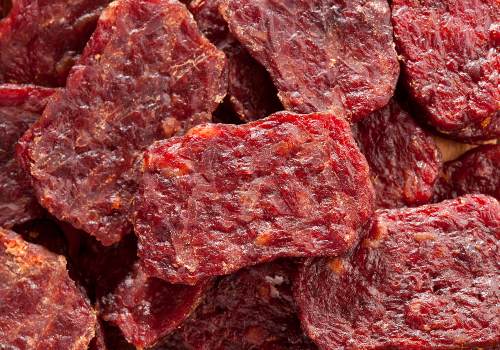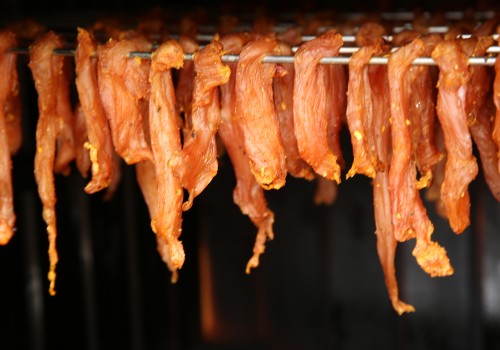Do You Need to Cook Beef Before Dehydrating
Foodborne illnesses are no joke, and that goes specially for meat-loving bacteria like Eastward. coli and salmonella. That's why homemade jerky aficionados need to know how to make beef jerky safely.
Preparing and storing your hasty in accord with food safety guidelines will make it last longer and continue you healthy, besides. And information technology's not as daunting a task as you might think!
Here are our top five tips for safe jerky making.
Making Safe Beef Jerky: V Piece of cake Tips

1. Keep Your Meat Common cold Until Cooking Time
It can exist tempting to thaw your beef on the kitchen counter so you can become effectually to making (and eating) your jerky sooner.
But letting your beef get up to room temperature is a recipe for bacterial disaster. Within hours or even minutes, dormant bacteria will wake up and new bacteria will begin to colonize your meat.
Contempo history provides us with ample cautionary tales. In late 2019, ix people were hospitalized and one died after eating ground beef contaminated with salmonella.
And several months earlier, over 200 people reportedly contracted E. coli after eating contaminated beef.
So to keep bacteria at bay, always thaw and marinate your meat in the fridge, keeping it at 36-xl degrees F. And don't remove it until you're gear up to gear up or dehydrate it!
2. Clean Your Kitchen and Tools
A dirty kitchen isn't just unsightly and unpleasant to be in. It'south besides a food prophylactic adventure, particularly when you're working with meat.
To be on the condom side, ever clean your kitchen and your tools before making beef jerky. That means sanitizing your countertops and cutting boards, thoroughly cleaning your knives and washing your dehydrator trays religiously.
And e'er launder your hands with soap and water earlier and afterward handling raw meat. Never touch your mouth or face with unwashed hands after handling raw meat, and make clean your knives and cutting boards before using them with other nutrient.
3. Use Curing Salt in Your Hasty Recipes
Not all beefiness hasty recipes telephone call for curing salt, and if you're organically-inclined, you may feel hesitant to use it or other preservatives when preparing your food.
But if you're worried about foodborne illness, adding curing salt to your beef jerky tin play a big part in stopping bacteria and making your hasty safer and longer-lasting.
Curing salt slows the growth of the harmful botulinum bacteria and other anaerobic bacteria. Botulinum causes botulism, a serious illness, and is difficult to kill, but curing salt makes your meat inhospitable for this dastardly bacteria.
Used properly, curing salt has no detrimental effects on human health and makes your jerky much safer to eat.
Read more nigh best curing common salt for beef jerky!
4. E'er Heat Your Jerky to 160 Degrees F

You need to keep your meat common cold while it's raw, but there's a minimum temperature information technology must accomplish while y'all're dehydrating it: 160 degrees F (or 165 degrees F for poultry jerky).
The USDA recommends heating your beef to 160 degrees at the beginning of the drying process. That'south because dried meat is more than rut resistant, so information technology may not become hot enough to kill all the bacteria if you lot rut it up afterwards drying.
If your food dehydrator tin can reach 160 degrees, then no extra labor on your function is needed. Just adapt your beef on the trays and let the dehydrator exercise its chore.
But if your dehydrator doesn't get that hot, you'll need to precook your beefiness in the oven before putting information technology in the dehydrator.
Preheat your oven to 300 degrees F, so put your marinated beef in for around ten minutes (thicker slices will take longer). You may want to wrap a slice around an oven thermometer to confirm that the beef has reached an internal temperature of 160 degrees.
And if you're using chicken or turkey for your jerky, heat it in a 300 degree oven until it reaches an internal temperature of 165 degrees. Poultry frequently heats upwardly faster than beef, so you may need less than 10 minutes to precook it.
This brief pre-cook will kill any harmful bacteria in your meat without affecting the texture or flavour of the final jerky.
5. Store or Freeze Your Jerky Appropriately
In one case your jerky is fully stale, it should be gratuitous from harmful bacteria and safe to consume. But unless you lot shop information technology properly, it won't remain safe for very long.
Although dried meat is much less appealing to bacteria than raw meat, information technology's even so susceptible to contamination. This is peculiarly true if it'south stored in a warm, humid environment, where bacteria thrive.
If you plan to consume all your jerky inside a week, you can store information technology in a sealed container in a cool, dry out place. Find a spot in a cupboard or pantry away from sinks, stoves and other sources of estrus and wet.
For longer-term storage, freezing is the best option. Ideally, you lot'll vacuum seal your hasty before freezing it, but you lot can also apply a freezer-safe container with an airtight seal.
Beefiness jerky will continue for upwardly to six months in a sealed container in the freezer. As with raw meat, just make sure to thaw it in the fridge (not on the counter!) earlier eating it.
Last update on 2022-05-30
QUOTE:
"You might be a redneck if you retrieve that beefiness hasty and moon pies are ii of the major food groups."
-- Jeff Foxworthy
Source: https://beefjerkyhub.com/how-to-make-beef-jerky-safely